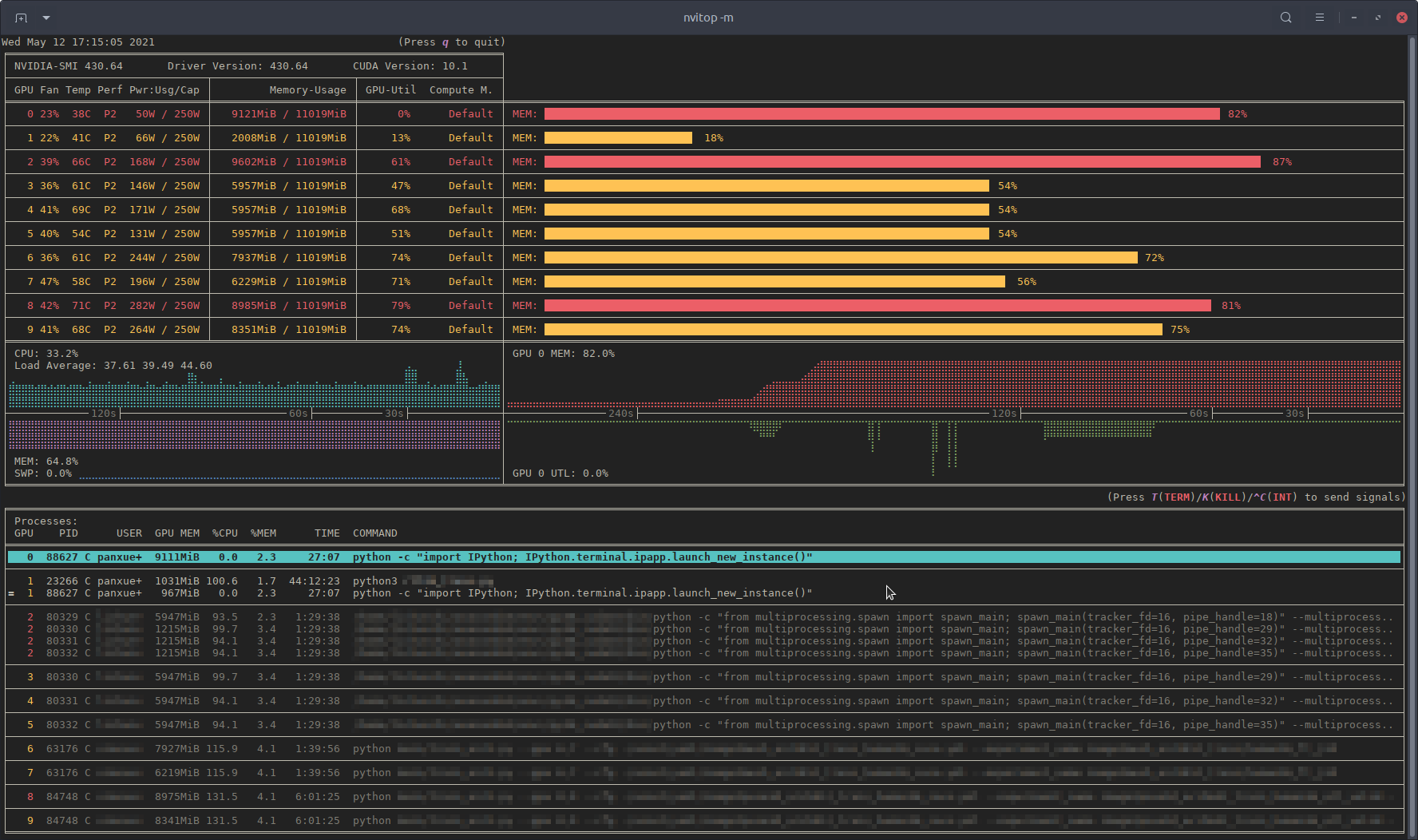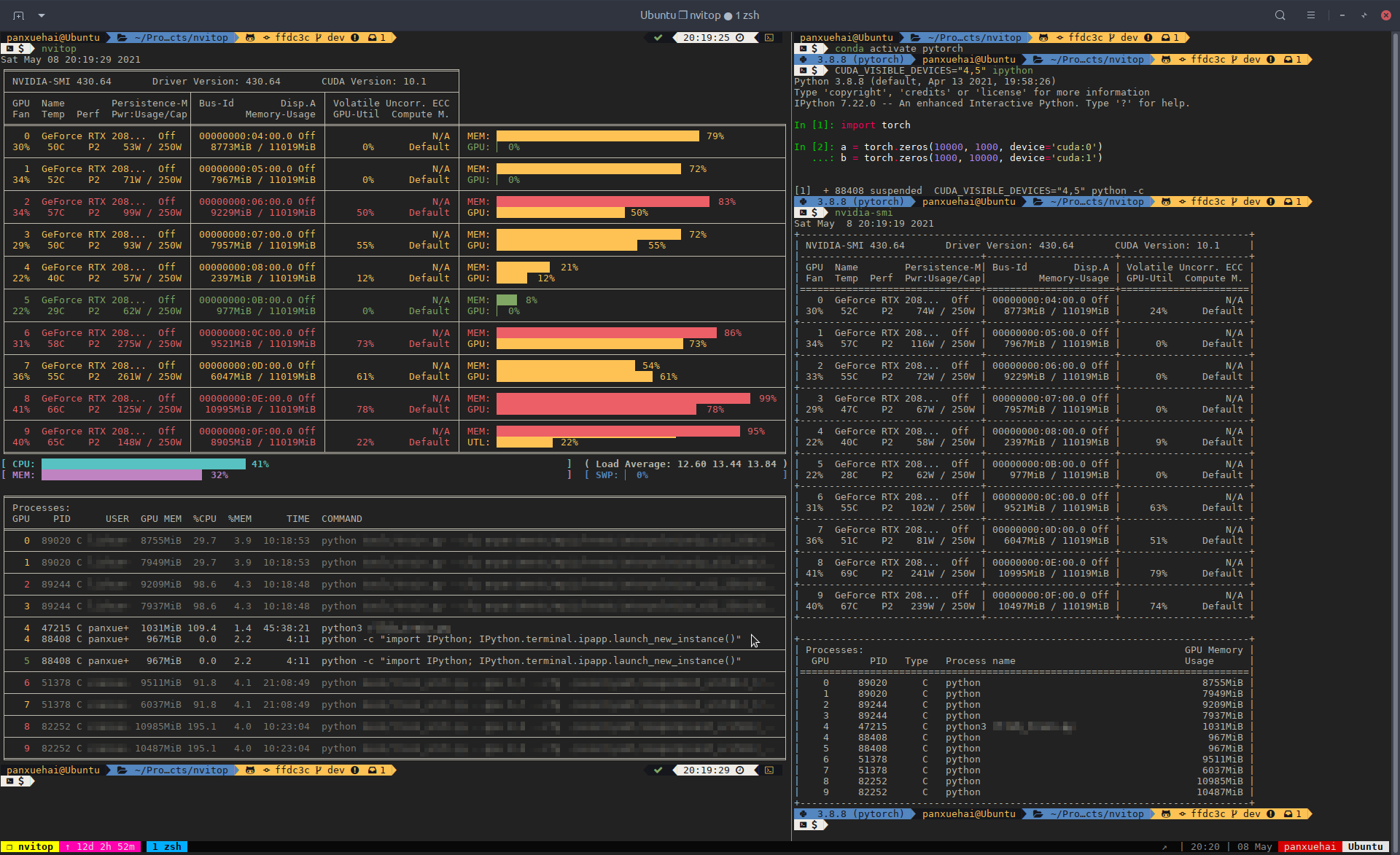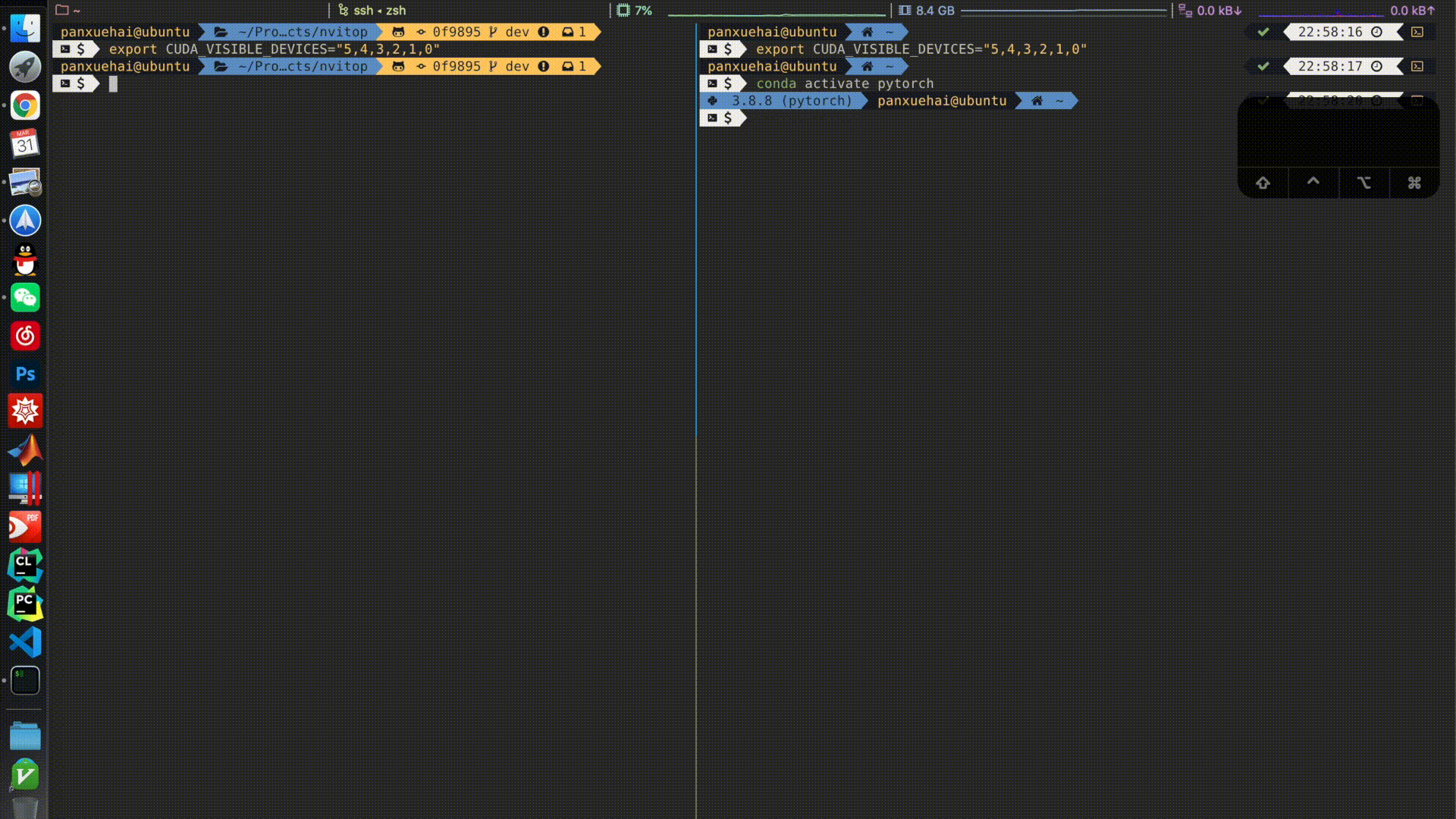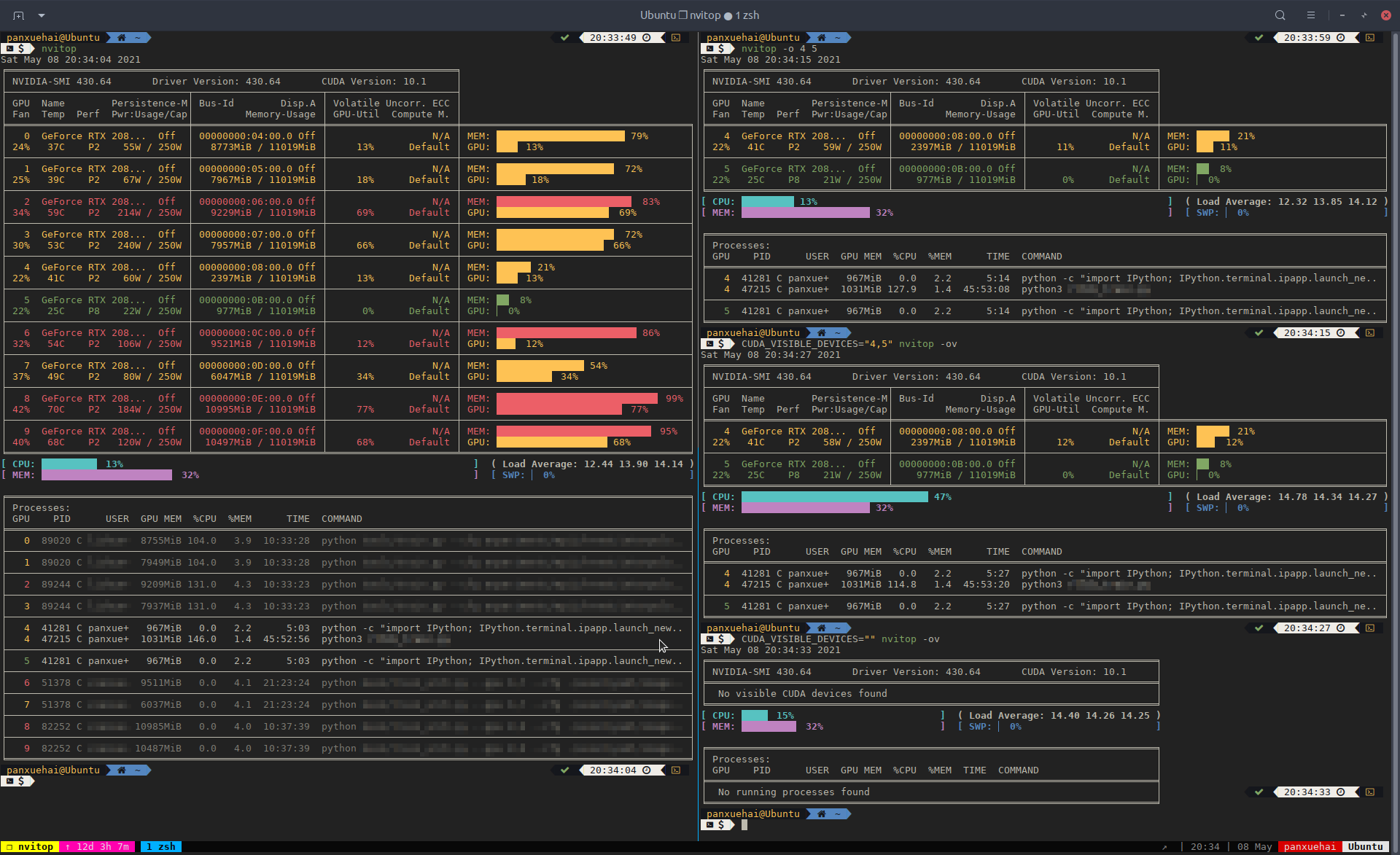An interactive NVIDIA-GPU process viewer, the one-stop solution for GPU process management.
Project description
nvitop
An interactive NVIDIA-GPU process viewer, the one-stop solution for GPU process management. (screenshots)
This project is inspired by nvidia-htop and nvtop for monitoring, and gpustat for integration.
nvidia-htop a tool for enriching the output of nvidia-smi. nvidia-htop uses regular expressions to read the output of nvidia-smi from a subprocess, which is inefficient. In the meanwhile, there is a powerful interactive GPU monitoring tool called nvtop. But nvtop is written in C, which makes it lack of portability. And What is really inconvenient is that you should compile it yourself during installation. Therefore, I made this repo. I got a lot help when reading the source code of ranger, the console file manager. Some files in this repo are copied and modified from ranger under the GPLv3 License.
So far, nvitop is in the beta phase, and most features have been tested on Linux. If you are using Windows with NVIDIA-GPUs, please submit feedback on the issue page, thank you very much!
If this repo is useful to you, please star ⭐️ it to let more people know 🤗.
Compare to nvidia-smi:
Features
- Informative and fancy output: show more information than
nvidia-smiwith colorized fancy box drawing. - Monitor mode: can run as a resource monitor, rather than print the results only once. (vs. nvidia-htop, limited support with command
watch -c) - Interactive: responsive for user inputs in monitor mode. (vs. gpustat & py3nvml)
- Efficient:
- query device status using NVML Python bindings directly, instead of parsing the output of
nvidia-smi. (vs. nvidia-htop) - cache results with
ttl_cachefrom cachetools. (vs. gpustat) - display information using the
curseslibrary rather thanprintwith ANSI escape codes. (vs. py3nvml)
- query device status using NVML Python bindings directly, instead of parsing the output of
- Portable: work on both Linux and Windows.
- get host process information using the cross-platform library psutil instead of calling
ps -p <pid>in a subprocess. (vs. nvidia-htop & py3nvml) - written in pure Python, easy to install with
pip. (vs. nvtop)
- get host process information using the cross-platform library psutil instead of calling
- Integrable: easy to integrate into other applications, more than monitoring. (vs. nvidia-htop & nvtop)
Requirements
- Python 3.5+
- NVIDIA Management Library (NVML)
- nvidia-ml-py
- psutil
- cachetools
- curses
- termcolor
Note: The NVIDIA Management Library (NVML) is a C-based programmatic interface for monitoring and managing various states. The runtime version of NVML library ships with the NVIDIA display driver (available at Download Drivers | NVIDIA), or can be downloaded as part of the NVIDIA CUDA Toolkit (available at CUDA Toolkit | NVIDIA Developer). The lists of OS platforms and NVIDIA-GPUs supported by the NVML library can be found in the NVML API Reference.
Installation
pip3 install --upgrade nvitop
Install the latest version from GitHub (recommended):
pip3 install git+https://github.com/XuehaiPan/nvitop.git#egg=nvitop
Or, clone this repo and install manually:
git clone --depth=1 https://github.com/XuehaiPan/nvitop.git
cd nvitop
pip3 install .
IMPORTANT: pip will install nvidia-ml-py==11.450.51 as a dependency for nvitop. Please verify whether the nvidia-ml-py package is compatible with your NVIDIA driver version. Otherwise, nvitop may not display the processes correctly due to the incompatibility. You can check the release history of nvidia-ml-py at nvidia-ml-py's Release History, and install the compatible version manually.
Usage
Query the device and process status. The output is similar to nvidia-smi, but has been enriched and colorized.
# Query status of all devices
$ nvitop
# Specify query devices
$ nvitop -o 0 1 # only show <GPU 0> and <GPU 1>
# Only show devices in `CUDA_VISIBLE_DEVICES`
$ nvitop -ov
Note: nvitop uses only one character to indicate the type of processes. C stands for compute processes, G for graphics processes, and X for both (i.e. MI(X), in nvidia-smi it is C+G).
Run as a resource monitor:
# Automatically configure the display mode according to the terminal size
$ nvitop -m
# Arbitrarily display as `full` mode
$ nvitop -m full
# Arbitrarily display as `compact` mode
$ nvitop -m compact
# Specify query devices
$ nvitop -m -o 0 1 # only show <GPU 0> and <GPU 1>
# Only show devices in `CUDA_VISIBLE_DEVICES`
$ nvitop -m -ov
Press q to return to the terminal.
For Docker users:
$ docker build -t nvitop:latest .
$ docker run -it --rm --gpus all --pid=host nvitop:latest -m
Type nvitop --help for more information:
usage: nvitop [--help] [--version] [--monitor [{auto,full,compact}]]
[--only idx [idx ...]] [--only-visible]
[--gpu-util-thresh th1 th2] [--mem-util-thresh th1 th2]
[--ascii]
A interactive NVIDIA-GPU process viewer.
optional arguments:
--help, -h show this help message and exit
--version show program's version number and exit
--monitor [{auto,full,compact}], -m [{auto,full,compact}]
Run as a resource monitor. Continuously report query data,
rather than the default of just once.
If no argument is given, the default mode `auto` is used.
--only idx [idx ...], -o idx [idx ...]
Only show the specified devices, suppress option `--only-visible`.
--only-visible, -ov Only show devices in environment variable `CUDA_VISIBLE_DEVICES`.
--gpu-util-thresh th1 th2
Thresholds of GPU utilization to distinguish load intensity.
Coloring rules: light < th1 % <= moderate < th2 % <= heavy.
( 1 <= th1 < th2 <= 99, defaults: 10 75 )
--mem-util-thresh th1 th2
Thresholds of GPU memory utilization to distinguish load intensity.
Coloring rules: light < th1 % <= moderate < th2 % <= heavy.
( 1 <= th1 < th2 <= 99, defaults: 10 80 )
--ascii Use ASCII characters only, which is useful for terminals without Unicode support.
Keybindings for monitor mode
| Key | Binding |
|---|---|
q |
Quit and return to the terminal. |
a / f / c |
Change the display mode to auto / full / compact. |
<Left> / <Right> [ / ] <S-Wheel> |
Scroll the host information of processes. |
<Home> <C-a> ^ |
Scroll the host information of processes to the beginning of line. |
<End> <C-e> $ |
Scroll the host information of selected processes to the end of line. |
<Up> / <Down> <Tab> / <S-Tab> <Wheel> |
Select and highlight process. |
<Esc> |
Clear selection. |
T |
Send signal.SIGTERM to the selected process (terminate). |
K |
Send signal.SIGKILL to the selected process (kill). |
I <C-c> |
Send signal.SIGINT to the selected process (interrupt). |
Note: Press the CTRL key to multiply the mouse wheel events by 5.
More than Monitoring
nvitop can be easily integrated into other applications like gpustat.
Device
In [1]: from nvitop.core import host, Device, HostProcess, GpuProcess
In [2]: Device.driver_version()
Out[2]: '430.64'
In [3]: Device.cuda_version()
Out[3]: '10.1'
In [4]: Device.count()
Out[4]: 10
In [5]: all_devices = Device.all()
...: all_devices
Out[5]: [
Device(index=0, name="GeForce RTX 2080 Ti", total_memory=11019MiB),
Device(index=1, name="GeForce RTX 2080 Ti", total_memory=11019MiB),
Device(index=2, name="GeForce RTX 2080 Ti", total_memory=11019MiB),
Device(index=3, name="GeForce RTX 2080 Ti", total_memory=11019MiB),
Device(index=4, name="GeForce RTX 2080 Ti", total_memory=11019MiB),
Device(index=5, name="GeForce RTX 2080 Ti", total_memory=11019MiB),
Device(index=6, name="GeForce RTX 2080 Ti", total_memory=11019MiB),
Device(index=7, name="GeForce RTX 2080 Ti", total_memory=11019MiB),
Device(index=8, name="GeForce RTX 2080 Ti", total_memory=11019MiB),
Device(index=9, name="GeForce RTX 2080 Ti", total_memory=11019MiB)
]
In [6]: nvidia0 = Device(0) # from device index
...: nvidia0
Out[6]: Device(index=0, name="GeForce RTX 2080 Ti", total_memory=11019MiB)
In [7]: nvidia0.memory_used() # in bytes
Out[7]: 9293398016
In [8]: nvidia0.memory_used_human()
Out[8]: '8862MiB'
In [9]: nvidia0.gpu_utilization() # in percentage
Out[9]: 5
In [10]: nvidia0.processes()
Out[10]: {
52059: GpuProcess(pid=52059, gpu_memory=7885MiB, type=C, device=Device(index=0, name="GeForce RTX 2080 Ti", total_memory=11019MiB), host=HostProcess(pid=52059, name='ipython3', status='sleeping', pid=tatus, started='14:31:22')),
53002: GpuProcess(pid=53002, gpu_memory=967MiB, type=C, device=Device(index=0, name="GeForce RTX 2080 Ti", total_memory=11019MiB), host=HostProcess(pid=53002, name='python', status='running', started='14:31:59'))
}
In [11]: nvidia1 = Device(bus_id='00000000:05:00.0') # from PCI bus ID
...: nvidia1
Out[11]: Device(index=1, name="GeForce RTX 2080 Ti", total_memory=11019MiB)
In [12]: nvidia1_snapshot = nvidia1.as_snapshot()
...: nvidia1_snapshot
Out[12]: DeviceSnapshot(
real=Device(index=1, name="GeForce RTX 2080 Ti", total_memory=11019MiB),
bus_id='00000000:05:00.0',
compute_mode='Default',
display_active='Off',
ecc_errors='N/A',
fan_speed='22%', # in percentage
gpu_utilization=17, # in percentage
gpu_utilization_string='17%', # in percentage
index=1,
memory_free=10462232576, # in bytes
memory_free_human='9977MiB',
memory_total=11554717696, # in bytes
memory_total_human='11019MiB',
memory_usage='1041MiB / 11019MiB',
memory_used=1092485120, # in bytes
memory_used_human='1041MiB',
memory_utilization=9, # in percentage
memory_utilization_string='9%', # in percentage
name='GeForce RTX 2080 Ti',
performance_state='P2',
persistence_mode='Off',
power_limit=250000, # in milliwatts (mW)
power_usage='66W / 250W', # in watts (W)
power_draw=66051, # in milliwatts (mW)
temperature='39C' # in Celsius
)
In [13]: nvidia1_snapshot.memory_utilization_string # snapshot uses properties instead of function calls
Out[13]: '9%'
In [14]: nvidia1_snapshot.encoder_utilization # snapshot will automatically retrieve not presented attributes from `real`
Out[14]: [0, 1000000]
In [15]: nvidia1_snapshot
Out[15]: DeviceSnapshot(
real=Device(index=1, name="GeForce RTX 2080 Ti", total_memory=11019MiB),
bus_id='00000000:05:00.0',
compute_mode='Default',
display_active='Off',
ecc_errors='N/A',
encoder_utilization=[0, 1000000], ##### <-- new entry #####
fan_speed='22%', # in percentage
gpu_utilization=17, # in percentage
gpu_utilization_string='17%', # in percentage
index=1,
memory_free=10462232576, # in bytes
memory_free_human='9977MiB',
memory_total=11554717696, # in bytes
memory_total_human='11019MiB',
memory_usage='1041MiB / 11019MiB',
memory_used=1092485120, # in bytes
memory_used_human='1041MiB',
memory_utilization=9, # in percentage
memory_utilization_string='9%', # in percentage
name='GeForce RTX 2080 Ti',
performance_state='P2',
persistence_mode='Off',
power_limit=250000, # in milliwatts (mW)
power_usage='66W / 250W', # in watts (W)
power_draw=66051, # in milliwatts (mW)
temperature='39C' # in Celsius
)
Process
In [16]: processes = nvidia1.processes()
...: processes
Out[16]: {
23266: GpuProcess(pid=23266, gpu_memory=1031MiB, type=C, device=Device(index=1, name="GeForce RTX 2080 Ti", total_memory=11019MiB), host=HostProcess(pid=23266, name='python3', status='running', started='2021-05-10 21:02:40'))
}
In [17]: process = processes[23266]
...: process
Out[17]: GpuProcess(pid=23266, gpu_memory=1031MiB, type=C, device=Device(index=1, name="GeForce RTX 2080 Ti", total_memory=11019MiB), host=HostProcess(pid=23266, name='python3', status='running', started='2021-05-10 21:02:40'))
In [18]: process.status()
Out[18]: 'running'
In [19]: process.cmdline()
Out[19]: ['python3', 'rllib_train.py']
In [20]: process.command()
Out[20]: 'python3 rllib_train.py'
In [21]: process.cwd()
Out[21]: '/home/xxxxxx/Projects/xxxxxx'
In [22]: process.gpu_memory_human()
Out[22]: '1031MiB'
In [23]: process.as_snapshot()
Out[23]: GpuProcessSnapshot(
real=GpuProcess(pid=23266, gpu_memory=1031MiB, type=C, device=Device(index=1, name="GeForce RTX 2080 Ti", total_memory=11019MiB), host=HostProcess(pid=23266, name='python3', status='running', started='2021-05-10 21:02:40')),
cmdline=['python3', 'rllib_train.py'],
command='python3 rllib_train.py',
cpu_percent=98.5,
cpu_percent_string='98.5%',
device=Device(index=1, name="GeForce RTX 2080 Ti", total_memory=11019MiB),
gpu_memory=1081081856, # in bytes
gpu_memory_human='1031MiB',
identity=(23266, 1620651760.15, 1),
is_running=True,
memory_percent=1.6849018430285683,
memory_percent_string='1.7%',
name='python3',
pid=23266,
running_time=datetime.timedelta(days=1, seconds=80013, microseconds=470024),
running_time_human='46:13:33',
type='C',
username='panxuehai'
)
In [24]: process.kill()
In [25]: list(map(Device.processes, all_devices)) # all processes
Out[25]: [
{
52059: GpuProcess(pid=52059, gpu_memory=7885MiB, type=C, device=Device(index=0, name="GeForce RTX 2080 Ti", total_memory=11019MiB), host=HostProcess(pid=52059, name='ipython3', status='sleeping', started='14:31:22')),
53002: GpuProcess(pid=53002, gpu_memory=967MiB, type=C, device=Device(index=0, name="GeForce RTX 2080 Ti", total_memory=11019MiB), host=HostProcess(pid=53002, name='python', status='running', started='14:31:59'))
},
{},
{},
{},
{},
{},
{},
{},
{
84748: GpuProcess(pid=84748, gpu_memory=8975MiB, type=C, device=Device(index=8, name="GeForce RTX 2080 Ti", total_memory=11019MiB), host=HostProcess(pid=84748, name='python', status='running', started='11:13:38'))
},
{
84748: GpuProcess(pid=84748, gpu_memory=8341MiB, type=C, device=Device(index=9, name="GeForce RTX 2080 Ti", total_memory=11019MiB), host=HostProcess(pid=84748, name='python', status='running', started='11:13:38'))
}
]
In [26]: import os
...: this = HostProcess(os.getpid())
...: this
Out[26]: HostProcess(pid=35783, name='python', status='running', started='19:19:00')
In [27]: this.cmdline()
Out[27]: ['python', '-c', 'import IPython; IPython.terminal.ipapp.launch_new_instance()']
In [27]: this.command() # not simply ''.join(cmdline) and quotes are added
Out[27]: 'python -c "import IPython; IPython.terminal.ipapp.launch_new_instance()"'
In [28]: import cupy as cp
...: x = cp.zeros((10000, 1000))
...: this = GpuProcess(os.getpid(), nvidia0) # explicitly construct from GpuProcess rather than device.processes() call
...: this
Out[28]: GpuProcess(pid=35783, gpu_memory=N/A, type=N/A, device=Device(index=0, name="GeForce RTX 2080 Ti", total_memory=11019MiB), host=HostProcess(pid=35783, name='python', status='running', started='19:19:00'))
In [29]: this.update_gpu_status() # update used GPU memory from new driver query
Out[29]: 267386880
In [30]: this
Out[30]: GpuProcess(pid=35783, gpu_memory=255MiB, type=C, device=Device(index=0, name="GeForce RTX 2080 Ti", total_memory=11019MiB), host=HostProcess(pid=35783, name='python', status='running', started='19:19:00'))
In [31]: id(this) == id(GpuProcess(os.getpid(), nvidia0)) # IMPORTANT: instance will be reused while process is running
Out[31]: True
Host (inherited from psutil)
In [32]: host.cpu_count()
Out[32]: 88
In [33]: host.cpu_percent()
Out[33]: 18.5
In [34]: host.cpu_times()
Out[34]: scputimes(user=2346377.62, nice=53321.44, system=579177.52, idle=10323719.85, iowait=28750.22, irq=0.0, softirq=11566.87, steal=0.0, guest=0.0, guest_nice=0.0)
In [35]: host.load_average()
Out[35]: (14.88, 17.8, 19.91)
In [36]: host.virtual_memory()
Out[36]: svmem(total=270352478208, available=192275968000, percent=28.9, used=53350518784, free=88924037120, active=125081112576, inactive=44803993600, buffers=37006450688, cached=91071471616, shared=23820632064, slab=8200687616)
In [37]: host.swap_memory()
Out[37]: sswap(total=65534947328, used=475136, free=65534472192, percent=0.0, sin=2404139008, sout=4259434496)
Screenshots
Example output of nvitop:
Example output of nvitop -m:
| Full | Compact |
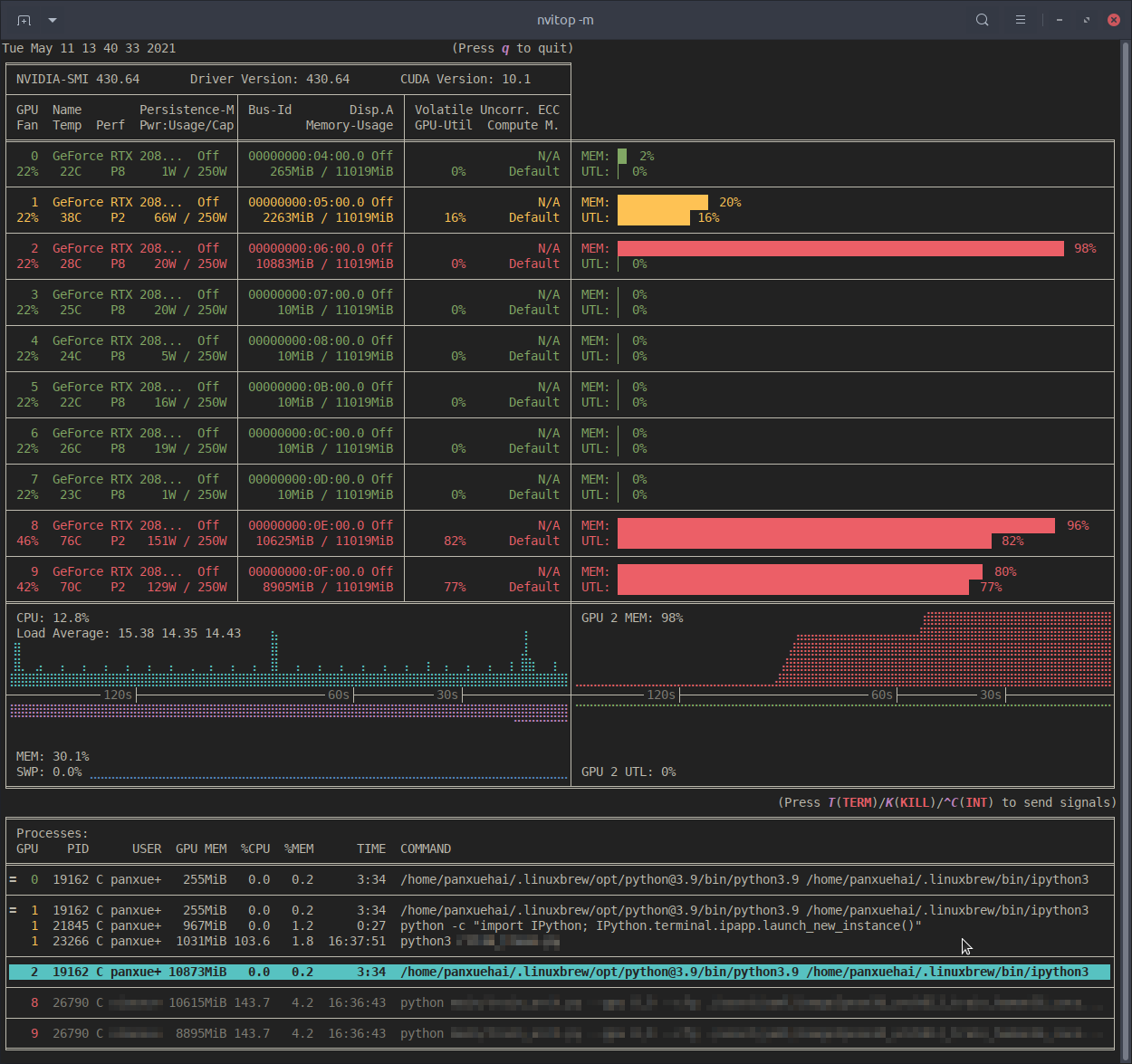 |
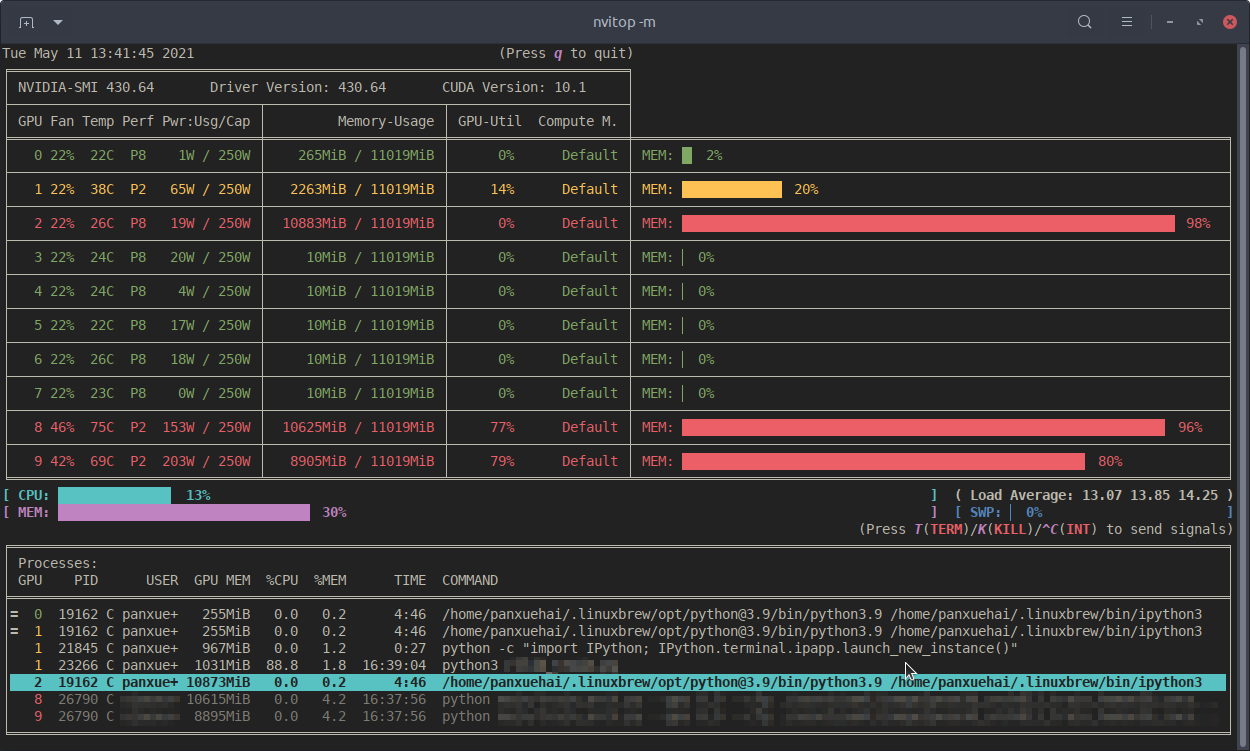 |
License
GNU General Public License, version 3 (GPLv3)
Project details
Release history Release notifications | RSS feed
Download files
Download the file for your platform. If you're not sure which to choose, learn more about installing packages.







